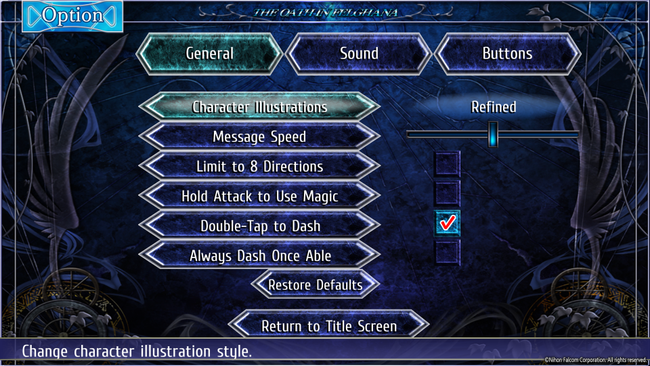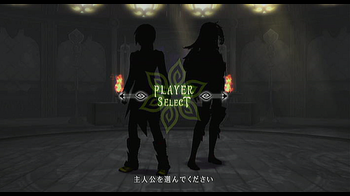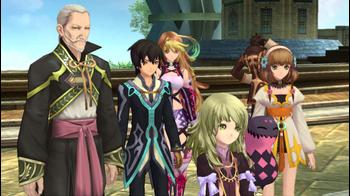
Tales of Xillia Import Review
The Tales of Series has been releasing games for 15 years and Tales of Xillia is its 15 Year Anniversary title. The game attempts to set itself apart from other JRPGs while moving forward from the designs that perhaps has plagued the industry for a long time. Utilizing a new combat system, a unique art style, a dual-perspective narrative, and an engine exclusively crafted for the PS3 unlike the two previous titles, is this game truly great?

Liese Maxia is a world full of people that rely on the power of Spirits to use every day goods. Whether it be for light or activating machinery, Spirits are needed. The two main protagonists are Jude Mathis, a 15 year-old male student aspiring to be a doctor studying in Il Fan, and Milla Maxwell, the Spirit Lord Maxwell in the form of a 20 year-old girl. While Jude is wandering the streets of Il Fan, he runs into Milla and both of them find themselves discovering a secret laboratory in the metropolis. As they journey together, Milla finds her powers and Spirit allies sealed away. Now proclaimed a traitor and a criminal, Jude runs away with Milla in hopes of finding out why her powers are sealed and the Spirits are declining.
The premise of the game doesn’t seem particularly special. In fact, the idea of a protagonist just being thrown into the fray of things is quite common but Xillia does it quite differently. There are two main protagonists and this allows for a unique narrative, especially considering infrequency of using this style in the genre. In the beginning of the game, you can choose to Milla's or Jude's perspective of the story. While you can control either one of them in battle, the game will force Milla and Jude to split up; and you won't get the full understanding of the story unless you complete both Jude and Milla's story.
The idea to have dual protagonists and a split narrative is quite clever but the execution is definitely not there. Most of the problems that arise in the narrative is due to Milla’s side. When progressing through the game, Milla will split up from the party a few times. During these times, Jude’s story is constantly progressing. When Milla rejoins with Jude, the story continues but it doesn't fill you in on what happened on Jude's side. As a result, this forces the you to play through Jude's side. While this doesn’t quite happen in Jude’s story, it is extremely frustrating to know that plot elements are left unanswered completely on one side of the story. It’s even more frustrating to know that the player has to play through both sides in order to understand even the basic plot. While the game attempts to craft an experience that will be unique depending on which character the player chooses, it’s not done efficiently.
On the bright side, the actual narrative is very good. In fact, the story is possibly one of the best in the series; this is due to the characters and the lack of fillers in the story. Alvin in particular is thrill to see in the cutscenes due to his nature and personality as the game constantly progresses. While the entire cast isn’t great, each character has an amazing story to tell as they tackle their own personal problems. It’s also great to note that the character backstory is perhaps one of the strongest in the game such as Leia and her issues with Jude, her childhood friend, and the decisions that led up to choosing being a nurse of sorts. Although these stories are extras, it’s a thrill to go through them moreso than its predecessors due to how enthralling each tales are.
The somewhat lackluster villains that have plagued the franchise for a while seems to have changed since the villains in Xillia actually have a strong motive to do what they believe is right. It is rightly so then that Xillia actually doesn’t have a binary white and black moral code like Graces or Abyss. Instead, many of Xillia’s characters actions sit on the gray side. Everyone has a motive or a level of resolve that compels them to do what they do. It is this type of development in both plot and character that truly differentiates Xillia from Graces, exceeds the thematic excellence that Vesperia accomplished, and character development that Abyss pushed for.
Combat has always been the strongest focus for the franchise and perhaps, oddly, it’s the weakest aspect of the game when considering Xillia as an entire package. The combat uses the Double-Raid Linear Motion Battle System (DRLMBS). Veterans of the series will notice that this game plays much more like Vesperia than it does Graces due to the lack of circular style of movement and more of a linear horizontal back and forth movement. The combat almost plays exactly like Vesperia but the little differences that add up make it a unique experience. You still controls only one character but you can link up with any of the remaining three party members. This link allows you to attack a single enemy together, essentially controlling both characters but the second in a bare bones sort of way.
However, the point of linking up to a character is to use special moves called Link Artes. Once you have accrued a certain amount of meter on your Overlimit Gauge, your character can use an Arte to activate the Link Arte. Depending on the character you link up with and the move you use, different Link Artes will be performed. It doesn’t end there though. If your Overlimit Gauge fills completely, the player can perform a series of Link Artes in succession until the meter depletes. This allows for you the create a method for all your Link Artes to hit effectively since certain ones blow enemies away or draw them close. It's an interesting idea one that doesn't let players get away with mindless button mashing all the time.
There is a TP system in place so whenever you uses an Arte, a certain amount is expended, however, unlike Vesperia it is much easier to regain TP in this game without the use of items. Jude in particular can replenish dozens of TP in a matter of seconds. Another difference from its predecessor is the use of a mechanic called Action Capacity (AC). Those who have played through Graces will realize that it is very similar to the CC. Each attack, whether it be an Arte or a normal one, will consume AC. In order to replenish this the character has to stand for a mere moment. While the AC is definitely an interesting addition, it’s not the best one. It’s odd that the the limitless possibility of creating combos through the various Artes would be limited by such an odd system.
Lastly, it’s worth mentioning that while the fights against the grunts are really fun and thrilling, the boss fights are not. Those who found the boss fights fun and enjoyable in titles previous to Xillia will quickly realize that it is not quite the case in this game. Bosses are frustratingly difficult to fight against because they can break out of combos quite easily and can normally take 10 hits before coming free. Added to the fact that certain bosses have cheap moves or will have stats that make them ridiculously strong, you have a recipe for disaster. It’s astonishingly weird that the boss fights, one of the best things about the series, has been reduced to a disaster that become a hassle instead of an enjoyable experience. Luckily the bosses are not the ones you will be fighting against for dozens and dozens of hours throughout its 40 hour story.
The progression of each character is done through a system called the Lilial Orb. Once you open up the system, a web-like hexagon grid will appear. Each point will have a node, that contains a certain stat increase; All the nodes are interconnected in some way and once you connect the nodes to fill a certain area, you will unlock an hidden orb. However, you can’t obtain a node if you have don’t have a node already unlocked adjacent to it. This means that while the starting points for the characters will be the same, the development will be different since there will be different routes to take. Prioritizing certain moves and stats by using this unlocking method means that you’ll develop your characters in a very specialized and unique way.
Unfortunately, while the customization seems very freeing, it’s not. Characters perform extremely well if they are developed the way they are supposed to. Jude and Alvin will benefit from Physical Attack stats while Milla and Rowen benefits from Magic Attack stats. The illusion of developing your character suddenly disappears once the flaws of this system is realized. Despite this, the idea of controlling the development of your characters in varied ways is interesting.
The audio of the game is great especially considering the MIDI-like track that Graces employed. The musical pieces are very enthusiastic and really drives you forward. The tracks range from a grandiose anthems to a very wonderful but exhilarating orchestra piece that is used in battle. All of these have great synergy and bring forth a feeling of truly wanting to care about the character troubles, the world’s suffering, and the trials overcome in each battle. It’s important to note that the voices of the characters actually seem average especially when considering how well done the soundtrack is. The voices fit each of the character quite well and they all exhibit excellent execution but it’s not until they are in a state of emotional extremes that the voices stand out. The audio package is definitely one of the finest that the series has ever seen.
Xillia is the first Tales games to actually be made for the PS3. This means that the graphical capability is tailored to fit the PS3 unlike Vesperia and Graces, which were ported to the PS3. Sadly, Xillia doesn’t astound technically. In a way it is disappointing due to textures often not being very detailed or just flat out plain. It is great then that the style and the artistic vision of the game is extraordinary. Using an oil-painting style, the world almost seems like a painting on the wall, expertly crafted. Each locale feels unique whether you visit the ambient city of Il Fan or the snowy recesses of the Khan Bark.
You can also control the camera at all times, which is a first for the franchise. This means you can have a good look at each environment you comes across. Unfortunately the plains, mountains, and other lands you traverse through to go from town to town are very bland and lack personalities altogether. Often times all of the areas in-between are large, empty, and the same but with a different set of colors to make it appear like it’s different. The art direction is absolutely phenomenal and it’s too bad that it only stops a few small steps from a perfect delivery.
There is definitely a level of replayability, as with all Tales games. There are a plethora of side quests and the inclusion of a dual-protagonist means that you can clear the game twice without having to go through the same thing over again, though you need to go through each character for the full experience. There is a coliseum-esque area like previous titles in the franchise and there are many items to collect. All of this bundled together with a fun battle system makes it very enjoyable to go through the game’s extras.
Tales of Xillia is a great game, despite its flaws. It actually makes many improvements that the franchise needed to adopt in order to become more modern such as the inclusion of a movable camera, the removal of dialogue boxes, and virtually everything becoming a cutscene. These little presentation changes allow Xillia to be a great package overall and while it’s somewhat difficult to overlook the flaws it does make, the game definitely does more right than it does wrong. If you’re an avid RPG gamer looking to delve into a very interesting world with characters that are extremely well-developed and a combat system that is action packed to boot, then you should check this game out.
Disclaimer: This game is only released in Japan meaning Japanese efficiency is highly recommended. It is possible to play with translations and little Japanese but you might not receive the full experience possible. An English release will be in 2013.


